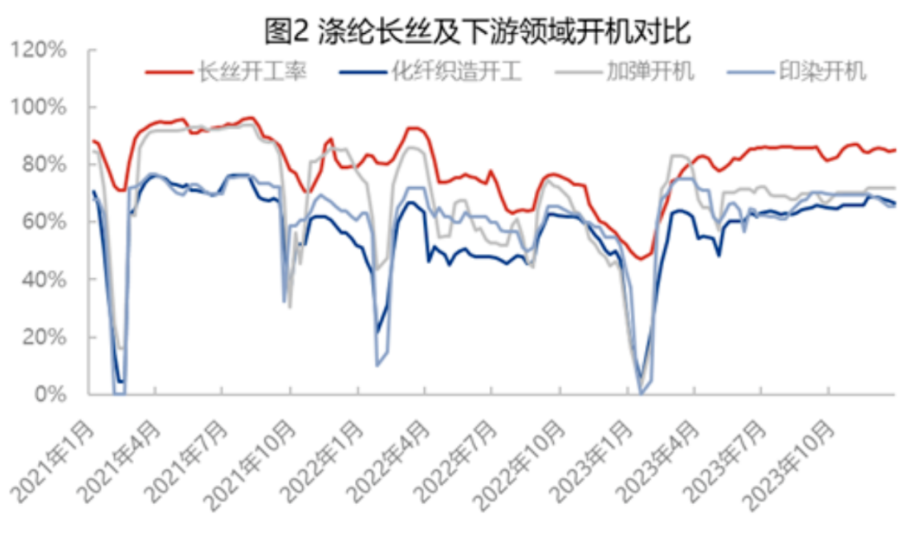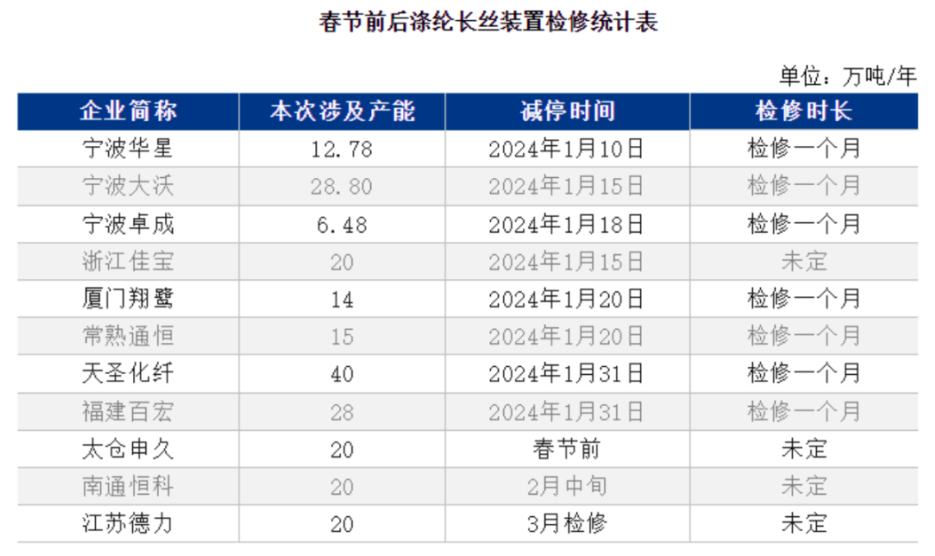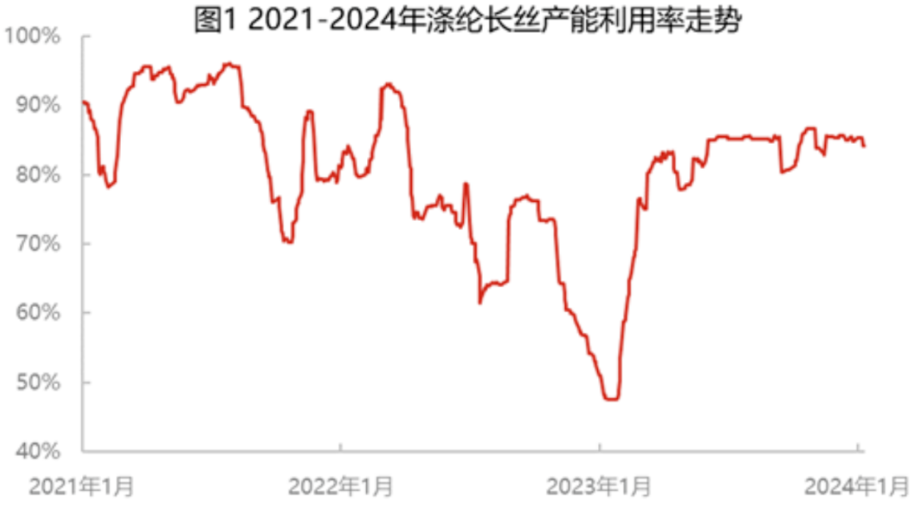Entering the countdown to the Spring Festival, polyester and downstream equipment maintenance news is frequent, although the surge in overseas orders in local areas is heard, it is difficult to conceal the fact that the industry’s opening probability is declining, as the Spring Festival holiday is approaching, polyester and terminal opening probability still has a declining trend.
Throughout the past three years, the capacity utilization rate of the polyester filament industry is in the process of gradual recovery after the trough period, especially since the second quarter of 2023, the industry capacity utilization rate has stabilized at the level of 80%, slightly lower than the capacity utilization level of the same period of polyester, but compared with 2022, the capacity utilization rate has increased by nearly 7 percentage points. However, since December 2023, the capacity utilization rate of polyester multi-varieties led by polyester filament has declined. According to statistics, in December, polyester filament reduction and stop devices totaled 5 sets, involving a production capacity of more than 1.3 million tons, and before and after the Spring Festival, there are still more than 10 sets of devices planned to stop and repair, involving a production capacity of more than 2 million tons.
At present, the polyester filament capacity utilization rate is near 85%, down 2 percentage points from the beginning of December last year, with the Spring Festival approaching, if the device is cut down as scheduled, it is expected that the domestic polyester filament capacity utilization rate will fall to near 81% before the Spring Festival. Risk aversion has increased, and at the end of the year, some polyester filament manufacturers have reduced negative risk aversion and dropped bags for safety. The downstream elastics, weaving and printing and dyeing fields have entered the negative cycle in advance. As early as mid-December, the overall opening probability of the industry has shown a downward trend, and after the New Year’s Day, some small-scale production enterprises have stopped in advance, and the opening probability of the industry has shown a slow decline.
There are structural changes in textile exports. According to statistics, from January to October 2023, China’s clothing (including clothing accessories, the same below) accumulated exports of 133.48 billion US dollars, down 8.8% year-on-year. Exports in October were $12.26 billion, down 8.9 percent from a year earlier. Affected by the worsening trend of sluggish international demand and a higher base in the first half of last year, clothing exports have slowed down the recovery trend, and the trend of returning to the scale before the occurrence of public health events is obvious.
As of October 23, China’s textile yarns, fabrics and products exports amounted to 113596.26 million US dollars; The total exports of clothing and clothing accessories amounted to US $1,357,498 million; Retail sales of clothing, shoes, hats and textiles totaled 881.9 billion yuan. From the perspective of major regional markets, from January to October, China’s export of textile yarns, fabrics and products to countries along the “Belt and Road” was 38.34 billion US dollars, an increase of 3.1%. Exports to RCEP member countries were 33.96 billion U.S. dollars, down 6 percent year-on-year. The export of textile yarns, fabrics and products to the six countries of the Gulf Cooperation Council in the Middle East was 4.47 billion US dollars, down 7.1% year-on-year. Exports of textile yarns, fabrics and products to Latin America were $7.42 billion, down 7.3% year on year. The export of textile yarns, fabrics and products to Africa was 7.38 billion US dollars, a significant increase of 15.7%. The export of textile yarns, fabrics and products to the five Central Asian countries was 10.86 billion US dollars, an increase of 17.6%. Among them, exports to Kazakhstan and Tajikistan increased by 70.8% and 45.2%, respectively.
Regarding the overseas inventory cycle, although the inventory of apparel and apparel fabric wholesalers in the United States is gradually eliminated with the completion of the overseas market, a new round of replenishment cycle may drive demand to pick up, but it is necessary to consider the linkage of the next retail to wholesale link, as well as the transmission mechanism and time of manufacturing orders.
At this stage, some weaving enterprises feedback, local overseas orders increased, but due to the impact of oil price shocks, geopolitical instability and other factors, enterprises are not willing to receive orders, most manufacturers plan to park after 20 days of this month, a small number of enterprises are expected to park on the eve of the Spring Festival holiday.
For weaving enterprises, the price of raw materials accounts for the vast majority of product costs, and is one of the most important factors affecting the price and profit of grey cloth. As a result, textile workers are extremely sensitive to changes in raw material prices.
Every year before the Spring Festival stocking is one of the most tangled downstream problems, in previous years, some downstream stocking before the Spring Festival, after the festival raw material prices continued to fall resulting in losses; Last year, most downstream before the festival did not stock, after the festival to see the raw materials straight up. The market is generally weak before the Spring Festival every year, but it is often unexpected after the festival. For this year, terminal consumer demand rebounded, low inventory in the industrial chain, but the industry’s expectations for the future 2024 industry are mixed, from the seasonal point of view, terminal demand will normally fall, pre-holiday shipments will only short-term drive local factory shipments to improve, the main tone of market demand is still light. At present, downstream users purchase more to maintain just demand, polyester filament enterprise inventory pressure is growing slowly, and the market is still expected to yield profits and ship in the middle.
Overall, in 2023, polyester production capacity increased by nearly 15% year-on-year, but from the fundamental point of view, the end demand is still slow to pick up. In 2024, polyester production capacity will slow down. Affected by the Indian BIS trade certification and other aspects, the future import and export situation of polyester is still worthy of attention.
Source: Lonzhong Information, network
Post time: Jan-19-2024




